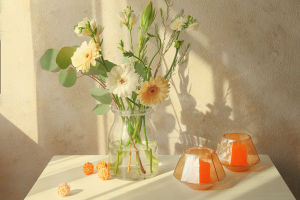More and more people are keeping plants at home. Plants can not only bring joy to life, relieve the pressure of life, but also make the air better. By watering the flowers and viewing the beauty of the flowers, you can also release stress and your mood will be lightened. However, you need to water them correctly. otherwise, the leaves will turn yellow or the flowers will not bloom, and even the roots will rot. Here are some tips for watering flowers.
1. How to judge the dryness and wetness of potting soil
Check to see if the soil in the pot is white. If the pot soil is white and the soil around the edge is cracked, it proves that the pot soil is dry and can be watered. If the soil doesn't turn white, still looks dark brown, and doesn't have gaps, then it's not that dry. Or you can tap to hear the sound. You can tap the top of the pot, if the sound is clear, it means that the soil is dry, but if it makes a muddy sound, it means that the soil is still wet.
2. How much to water
You need to wait until the soil dries out before watering, be sure to water thoroughly when you do it. If you don't know if you have watered it thoroughly, you can observe whether there is water seepage at the bottom of the flowerpot. Only by watering in this way will the roots of the plants absorb enough water, and there will be no water accumulation, which will lead to the emergence of rotten roots, to make sure your flowers will naturally grow very well.
3. Seasons for watering
The temperature difference between summer and winter is very large, and when we water the flowers, we also need to have different amounts. In autumn, the climate is dry, and the water that is poured out is very easy to evaporate. In summer and autumn, many flowers are also in the growing period, and the demand for water is large, so more watering in summer and autumn. In winter, when the temperature is very low, many plants not only grow slowly, but some directly enter the dormant period. At this time, it is necessary to control the amount of watering, or not to water. Otherwise, the soil is easy to freeze, the roots of the plant will be frostbitten, and the flowers and plants will be useless.
4. Time to water
For watering in summer and autumn, it is best to choose morning or evening. The sun at noon is too strong, and if you water the flowers, it is more likely to cause them to wilt. In spring and winter, it is best to choose a warm noon for watering, because the cold weather in the morning and evening is prone to frostbite.
5. Water with leftover tea
Some people like to drink tea. Don't throw away the leftover tea. The leftover tea can be used to water flowers because it contains some nutrients such as nitrogen, which not only keeps the soil moisture, but also provides some nutrients to the flowers.
6. Water with expired milk
Do not pour out the milk after it has expired. It can be used to water flowers, but you cannot use milk to water flowers directly. You need to add water to the milk, and the diluted milk can be used to water flowers.
7. Water with cool boiled water or warm water
Watering the flowers with cool boiled water can make the branches and leaves lusher and promote the flowers to bloom earlier. But do not water the flowers with cold water when the weather is cold, because the temperature of the soil will also affect the growth of the flowers. Therefore, it is best to use warm water to water the flowers in winter.
8. Water with rice water
A lot of people have heard about the benefit of rice water, but don’t use this water directly to water your plants. Rice water needs to be fermented and then absorbed, so that the flowers can grow more lushly, and the flowers will bloom more. bright.


